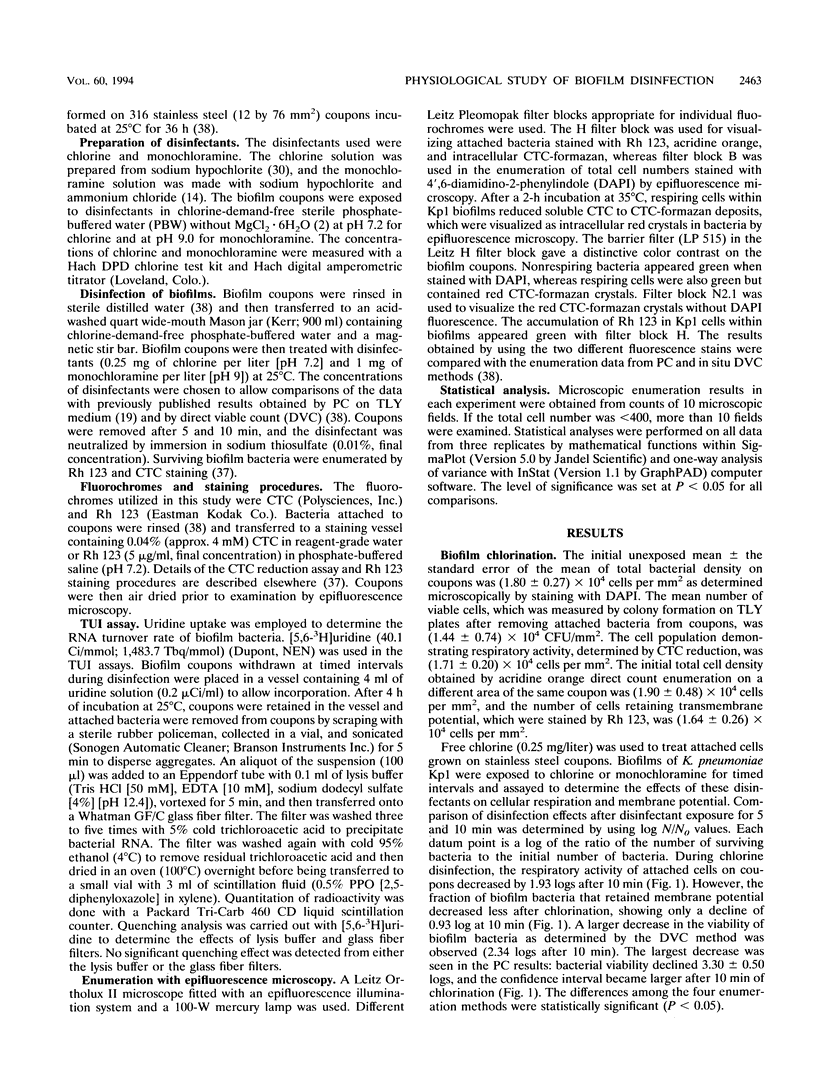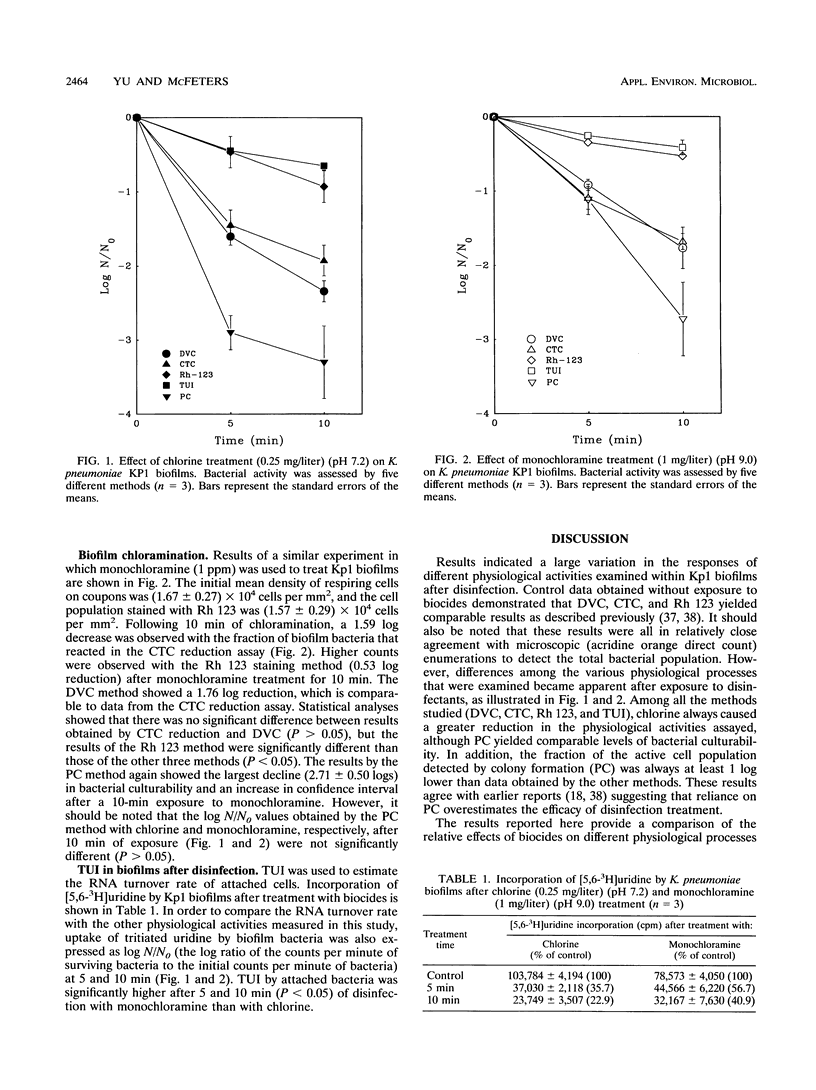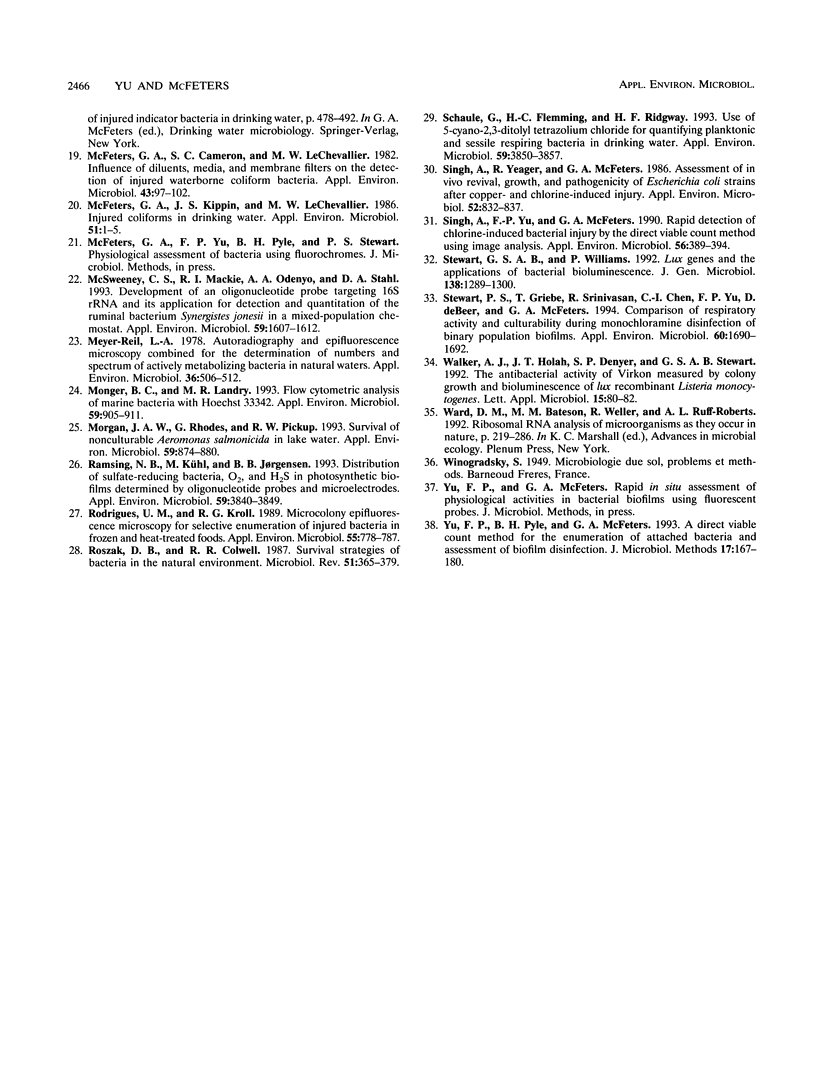Abstract
In situ enumeration methods using fluorescent probes and a radioisotope labelling technique were applied to evaluate physiological changes of Klebsiella pneumoniae within biofilms after disinfection treatment. Chlorine (0.25 mg of free chlorine per liter [pH 7.2]) and monochloramine (1 mg/liter [pH 9.0]) were employed as disinfectants in the study. Two fluorgenic compounds, 5-cyano-2,3-ditolyl tetrazolium chloride and rhodamine 123, and tritiated uridine incorporation were chosen for assessment of physiological activities. Results obtained by these methods were compared with those from the plate count and direct viable count methods. 5-Cyano-2,3-ditolyl tetrazolium chloride is an indicator of bacterial respiratory activity, rhodamine 123 is incorporated into bacteria in response to transmembrane potential, and the incorporation of uridine represents the global RNA turnover rate. The results acquired by these methods following disinfection exposure showed a range of responses and suggested different physiological reactions in biofilms exposed to chlorine and monochloramine. The direct viable count response and respiratory activity were affected more by disinfection than were the transmembrane potential and RNA turnover rate on the basis of comparable efficiency as evaluated by plate count enumeration. Information revealed by these approaches can provide different physiological insights that may be used in evaluating the efficacy of biofilm disinfection.
Full text
PDF




Selected References
These references are in PubMed. This may not be the complete list of references from this article.
- Allman R., Hann A. C., Manchee R., Lloyd D. Characterization of bacteria by multiparameter flow cytometry. J Appl Bacteriol. 1992 Nov;73(5):438–444. doi: 10.1111/j.1365-2672.1992.tb05001.x. [DOI] [PubMed] [Google Scholar]
- Cargill K. L., Pyle B. H., Sauer R. L., McFeters G. A. Effects of culture conditions and biofilm formation on the iodine susceptibility of Legionella pneumophila. Can J Microbiol. 1992 May;38(5):423–429. doi: 10.1139/m92-071. [DOI] [PubMed] [Google Scholar]
- Costerton J. W., Cheng K. J., Geesey G. G., Ladd T. I., Nickel J. C., Dasgupta M., Marrie T. J. Bacterial biofilms in nature and disease. Annu Rev Microbiol. 1987;41:435–464. doi: 10.1146/annurev.mi.41.100187.002251. [DOI] [PubMed] [Google Scholar]
- Davies D. G., McFeters G. A. Growth and comparative physiology of Klebsiella oxytoca attached to granular activated carbon particles and in liquid media. Microb Ecol. 1988;15(2):165–175. doi: 10.1007/BF02011710. [DOI] [PubMed] [Google Scholar]
- LeChevallier M. W., Cawthon C. D., Lee R. G. Factors promoting survival of bacteria in chlorinated water supplies. Appl Environ Microbiol. 1988 Mar;54(3):649–654. doi: 10.1128/aem.54.3.649-654.1988. [DOI] [PMC free article] [PubMed] [Google Scholar]
- LeChevallier M. W., Cawthon C. D., Lee R. G. Inactivation of biofilm bacteria. Appl Environ Microbiol. 1988 Oct;54(10):2492–2499. doi: 10.1128/aem.54.10.2492-2499.1988. [DOI] [PMC free article] [PubMed] [Google Scholar]
- McFeters G. A., Cameron S. C., LeChevallier M. W. Influence of diluents, media, and membrane filters on detection fo injured waterborne coliform bacteria. Appl Environ Microbiol. 1982 Jan;43(1):97–103. doi: 10.1128/aem.43.1.97-103.1982. [DOI] [PMC free article] [PubMed] [Google Scholar]
- McFeters G. A., Kippin J. S., LeChevallier M. W. Injured coliforms in drinking water. Appl Environ Microbiol. 1986 Jan;51(1):1–5. doi: 10.1128/aem.51.1.1-5.1986. [DOI] [PMC free article] [PubMed] [Google Scholar]
- McSweeney C. S., Mackie R. I., Odenyo A. A., Stahl D. A. Development of an oligonucleotide probe targeting 16S rRNA and its application for detection and quantitation of the ruminal bacterium Synergistes jonesii in a mixed-population chemostat. Appl Environ Microbiol. 1993 May;59(5):1607–1612. doi: 10.1128/aem.59.5.1607-1612.1993. [DOI] [PMC free article] [PubMed] [Google Scholar]
- Meyer-Reil L. A. Autoradiography and epifluorescence microscopy combined for the determination of number and spectrum of actively metabolizing bacteria in natural water. Appl Environ Microbiol. 1978 Sep;36(3):506–512. doi: 10.1128/aem.36.3.506-512.1978. [DOI] [PMC free article] [PubMed] [Google Scholar]
- Monger B. C., Landry M. R. Flow cytometric analysis of marine bacteria with hoechst 33342. Appl Environ Microbiol. 1993 Mar;59(3):905–911. doi: 10.1128/aem.59.3.905-911.1993. [DOI] [PMC free article] [PubMed] [Google Scholar]
- Morgan J. A., Rhodes G., Pickup R. W. Survival of nonculturable Aeromonas salmonicida in lake water. Appl Environ Microbiol. 1993 Mar;59(3):874–880. doi: 10.1128/aem.59.3.874-880.1993. [DOI] [PMC free article] [PubMed] [Google Scholar]
- Ramsing N. B., Kühl M., Jørgensen B. B. Distribution of sulfate-reducing bacteria, O2, and H2S in photosynthetic biofilms determined by oligonucleotide probes and microelectrodes. Appl Environ Microbiol. 1993 Nov;59(11):3840–3849. doi: 10.1128/aem.59.11.3840-3849.1993. [DOI] [PMC free article] [PubMed] [Google Scholar]
- Rodrigues U. M., Kroll R. G. Microcolony epifluorescence microscopy for selective enumeration of injured bacteria in frozen and heat-treated foods. Appl Environ Microbiol. 1989 Apr;55(4):778–787. doi: 10.1128/aem.55.4.778-787.1989. [DOI] [PMC free article] [PubMed] [Google Scholar]
- Roszak D. B., Colwell R. R. Survival strategies of bacteria in the natural environment. Microbiol Rev. 1987 Sep;51(3):365–379. doi: 10.1128/mr.51.3.365-379.1987. [DOI] [PMC free article] [PubMed] [Google Scholar]
- Schaule G., Flemming H. C., Ridgway H. F. Use of 5-cyano-2,3-ditolyl tetrazolium chloride for quantifying planktonic and sessile respiring bacteria in drinking water. Appl Environ Microbiol. 1993 Nov;59(11):3850–3857. doi: 10.1128/aem.59.11.3850-3857.1993. [DOI] [PMC free article] [PubMed] [Google Scholar]
- Schaule G., Flemming H. C., Ridgway H. F. Use of 5-cyano-2,3-ditolyl tetrazolium chloride for quantifying planktonic and sessile respiring bacteria in drinking water. Appl Environ Microbiol. 1993 Nov;59(11):3850–3857. doi: 10.1128/aem.59.11.3850-3857.1993. [DOI] [PMC free article] [PubMed] [Google Scholar]
- Singh A., Yeager R., McFeters G. A. Assessment of in vivo revival, growth, and pathogenicity of Escherichia coli strains after copper- and chlorine-induced injury. Appl Environ Microbiol. 1986 Oct;52(4):832–837. doi: 10.1128/aem.52.4.832-837.1986. [DOI] [PMC free article] [PubMed] [Google Scholar]
- Singh A., Yu F. P., McFeters G. A. Rapid detection of chlorine-induced bacterial injury by the direct viable count method using image analysis. Appl Environ Microbiol. 1990 Feb;56(2):389–394. doi: 10.1128/aem.56.2.389-394.1990. [DOI] [PMC free article] [PubMed] [Google Scholar]
- Stewart G. S., Williams P. lux genes and the applications of bacterial bioluminescence. J Gen Microbiol. 1992 Jul;138(7):1289–1300. doi: 10.1099/00221287-138-7-1289. [DOI] [PubMed] [Google Scholar]
- Stewart P. S., Griebe T., Srinivasan R., Chen C. I., Yu F. P., deBeer D., McFeters G. A. Comparison of respiratory activity and culturability during monochloramine disinfection of binary population biofilms. Appl Environ Microbiol. 1994 May;60(5):1690–1692. doi: 10.1128/aem.60.5.1690-1692.1994. [DOI] [PMC free article] [PubMed] [Google Scholar]
- Walker A. J., Holah J. T., Denyer S. P., Stewart G. S. The antibacterial activity of Virkon measured by colony growth and bioluminescence of lux recombinant Listeria monocytogenes. Lett Appl Microbiol. 1992 Aug;15(2):80–82. doi: 10.1111/j.1472-765x.1992.tb00730.x. [DOI] [PubMed] [Google Scholar]
- Yu F. P., Pyle B. H., McFeters G. A. A direct viable count method for the enumeration of attached bacteria and assessment of biofilm disinfection. J Microbiol Methods. 1993 Apr;17(3):167–180. doi: 10.1016/0167-7012(93)90044-i. [DOI] [PubMed] [Google Scholar]


